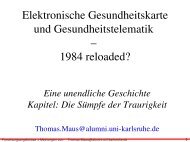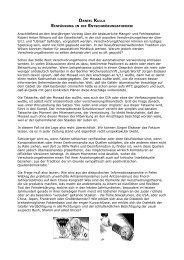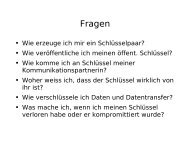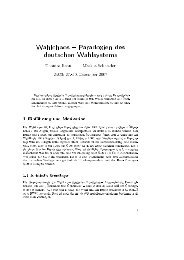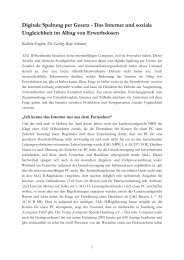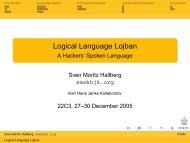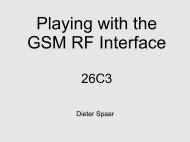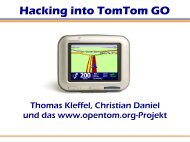Complete Hard Disk Encryption Using FreeBSD's GEOM Framework
Complete Hard Disk Encryption Using FreeBSD's GEOM Framework
Complete Hard Disk Encryption Using FreeBSD's GEOM Framework
You also want an ePaper? Increase the reach of your titles
YUMPU automatically turns print PDFs into web optimized ePapers that Google loves.
In fact, the node ad0s1.bdea does not even exist until the slice has been successfully<br />
attached, because without having the key (and the lockfile), the kernel cannot know that<br />
there is a partition inside the encrypted slide.<br />
Scenario: multiple operating systems on the same disk<br />
It is also possible to have multiple operating systems on the same disk – each on its<br />
own slice. The slice containing FreeBSD can be encrypted completely, hiding even the<br />
fact that the FreeBSD slice contains multiple partitions inside (boot, swap, etc). This way,<br />
all data on the FreeBSD slice remains protected, while the other operating systems on<br />
the machine can function normally on their unencrypted slices. In fact, they cannot even<br />
compromise the data on the FreeBSD slice – even if an attacker manages to get root<br />
access to a system residing on an unencrypted slice.<br />
3.4.5 Creating the filesystem<br />
Now that device nodes for the encrypted partitions exist, filesystems can be created on<br />
them:<br />
# newfs /dev/ad0.bdea<br />
# newfs /dev/ad0.bded<br />
etc.<br />
Note that the swap partition does not need a filesystem; the 'c' partition represents<br />
the entire (encrypted) disk. This partition must not be formated or otherwise be<br />
modified!<br />
3.4.6 Installing FreeBSD<br />
Now that the filesystems have been created, FreeBSD can be installed on the encrypted<br />
hard disk. Usually, this would be done using sysinstall again. But just as<br />
sysinstall cannot partition and format encrypted media, it cannot install the system<br />
on them. The distributions that comprise the FreeBSD operating system, therefore have<br />
to be installed manually.<br />
The FreeBSD installation disc contains a directory that is named after the release<br />
version of the system, for example: 5.4RELEASE, 6.0BETA etc. In this directory, each<br />
distribution – such as base, manpages or src – has its own subdirectory with an<br />
install.sh script. The base distribution is required, all others are optional.<br />
In order to install the distributions, the encrypted boot partition (and others, if used<br />
for example for /usr) has to be mounted and the environment variable DESTDIR set to<br />
the path where the encrypted boot partition has been mounted. Then all distributions<br />
can be installed using their respective install.sh script.<br />
The following example assumes that the encrypted boot partition /dev/ad0.bdea has<br />
been mounted on /fixed and the FreeBSD installation disc on /dist (the “livefilesystem”<br />
default). If the livefilesystem is used, the /fixed directory is easy to create because the<br />
root (/) is a memory disk.<br />
# mount /dev/ad0.bdea /fixed<br />
# export DESTDIR=/fixed/<br />
11



